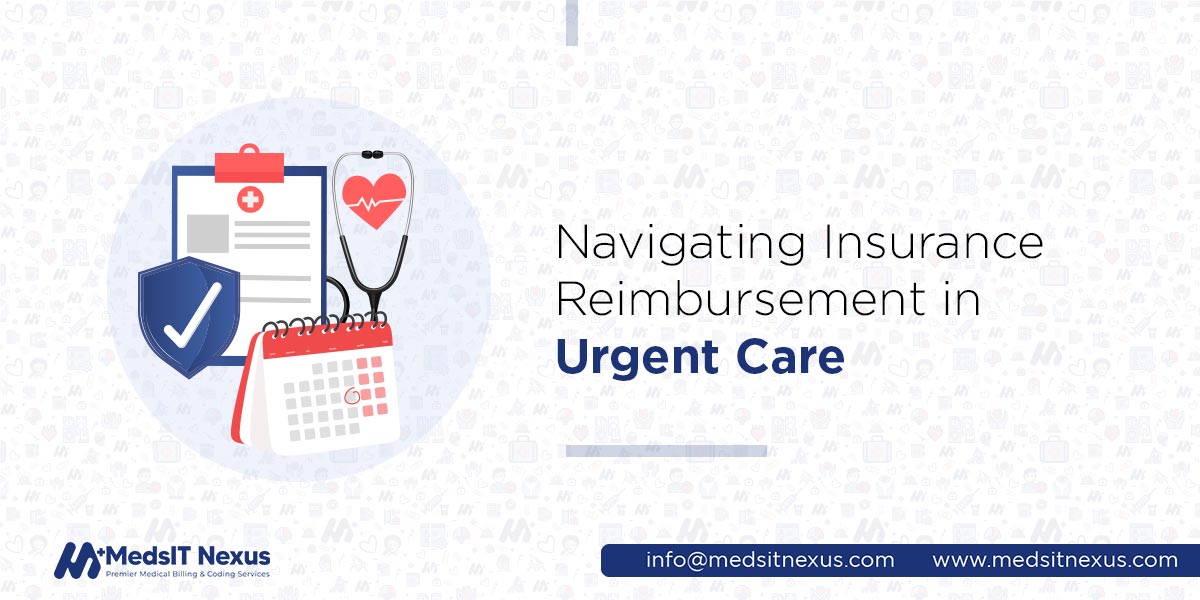Navigating Insurance Reimbursement in Urgent Care

Insurance coverage plays a vital role in determining reimbursement, accessibility, and affordability of healthcare services; hence, understanding the relationship between urgent care services and insurance reimbursement is necessary for making informed decisions. Moreover, to keep an urgent care facility financially healthy, it is necessary to understand the different reimbursement methods from insurance companies. In healthcare or urgent care insurance, a reimbursement process is a method of third-party repayment to offset the use of medical services and supplies. However, it is not easy to smoothly navigate and follow insurance reimbursement in urgent care organizations because urgent care billing is different and complex, requiring professionalism, efficiency, focus, skills, expertise, and compliance with the changing guidelines of insurance companies. To gain timely reimbursement from insurers, it is required to put in effort and time, which, according to healthcare practitioners, is not possible because they have to provide value-based care to patients, leading to errors in any step of billing and distorted RCM. To reduce this burden, handling the insurance reimbursement process to a 3rd party, an experienced billing company. MedsIT Nexus stands out as a professional company providing billing, coding, and reimbursement services to urgent care practices all across the USA
Navigating Insurance Coverage for Urgent Care: Maximize Reimbursement
In developed countries such as the USA, UK, Australia, and Canada, urgent and health care services are usually positioned in an ill‐defined space somewhere between family or general practice (GP) and emergency hospital and ambulance care. The insurance reimbursement process involves stakeholders such as patients, healthcare providers, and insurers. To seamlessly navigate this process, let's get some knowledge about it.
How does insurance reimbursement work?
When an urgent care provider sends a claim to the insurance company to get payment for rendered services, the insurance company adjudicates the claim, approves it if it is accurate, and finally sends you the payment; all this is included in the insurance reimbursement process. Let's talk about these basic steps that need to be followed.
Insurance coverage verification
It is professional behavior to check if the patient's insurer pays for the service or not so that you
can inform your patient about their financial responsibility and out-of-pocket (OOP) expenses such as
copayments and deductibles.
The insurance verification process involves some steps, such as
- Collecting patient and insurer’s information
- Contacting the insurer to confirm the policy's active status, type of coverage, effective date, deductibles, and copays
- Benefits verification for understanding services covered, pre-authorization requirements, and limitations of services
Submission of insurance claims
Claims facilitate a smooth payment transfer between the healthcare provider and third-party payer.
Claims data encompasses information entered on claims or bills submitted by physicians to third-party
payers (insurers). The claim data details numerous financial metrics, such as costs, expenses, charges,
and reimbursement. Keep a few things in mind before filing a claim.
Document the details necessary for payment: These claim data typically comprise
documenting information about examination, diagnosis, procedure, and treatments rendered, as well as
prescription information/treatment plan.
Assign correct codes: Coder may enter inaccurate information due to wrong decisions
about what to do, misreading of patient records, or typographical mistakes. Moreover, coding changes
that occur in response to changes in reimbursement policies add an extra layer of complexity to coding
variability. To escape the issue, flawless claims submission requires accurate coding that adheres to
the insurance company guidelines, POS-20, and coding rules. S codes and CPT codes
are commonly preferred for urgent care coding; however, submitting a claim without putting
modifiers 25, 59, and 57 where it
was necessary might result in claim denial. S9093 is a one-size-fits-all globe code, and many MCOs in
different states use this case-rate method for reimbursement. S9088 would be implemented for services
provided in urgent care (list in addition to code for services).
Auditing: Conducting audits such as retrospective and prospective audits, as well as
implementing technology, will assist in finely leading this step.
Adjudication
After successfully submitting a claim, the insurance company reviews it for its accuracy and
authenticity and then processes it. The claims processing systems encompass an automated adjudication
system, a benefits system, a payment system, and, last but not least, a payment tracking system.
Claim adjudication involves the following steps:
Initial reviewing of claim to check patient's name and other information, diagnosis,
and service codes.
Automatic reviewing of claims for more detailed scanning to check if the service was
medically necessary.
Manual reviewing (just 20%) is done by sharing claims with the medical claim examiner.
Decision is made after checking accuracy by implementing 1st three steps. Insurers will
agree to reimburse if the claim adheres to the finest quality; otherwise, it may get denied.
Appeal management
Appeal becomes necessary if insurers say that service was not medically necessary and deny the claim.
Urgent care practitioners might go through 3 crucial steps/levels in such cases.
Level 1: It is called the initial appeal in which the urgent care provider contacts the
insurer to ensure that the rendered service meets the insurers' rules and is reimbursable. For this
appeal, you can share the details of the patient's case, tell the reason why it was medically necessary,
or share relevant research data.
Level 2: This level is performed after there is a failure in level 1, and now you are
required to make a case to justify that your services fall under the category of payer's rules. At this
level, a director from the payer company who has not reviewed the claim will adjudicate the claim.
Level 3: External review is the final appeal in which someone who does not belong to
the insurance company will review your claim.
Does Insurance Cover Urgent Care Visits?
Yes, most insurers cover urgent care visits and services. However, insurance coverage depends on the
type of insurance plan and the urgent care facility you have chosen. Investopedia says that you have
different levels of coverage for various kinds of services, depending on your insurance plan.
Research says that for those individuals who purchased independent private insurance plans, the coverage
may vary with some plans that have similar coinsurance, copayment, and deductibles as employer-sponsored
programs, while others provide flexibility regarding cost-sharing options.
Different types of insurance coverages for reimbursement in urgent care are given below.
| Preferred Provider Organizations (PPOs) | It allows you to choose the healthcare provider of your choice, and you don't need a referral to go to an out-of-network provider. |
| Health Maintenance Organizations (HMOs) | It demands in-network providers; patients will need referrals if they go to out-of-network providers. |
| Point of Service Plan (POS) | It provides freedom in selecting which healthcare provider you want to visit; however, if the patient chooses an out-of-network provider, they should submit a claim independently. |
| Exclusive Provider Organization (EPO) | It often asks patients to choose an in-network provider; moreover, you must get pre-authorization for some services. |
| Medicaid and Medicare | These government plans play a vital role in providing coverage for particular groups of people. For example, Medicaid covers services with little or no out-of-pocket expenses for low-income individuals. Meanwhile, Medicare offers coverage for urgent care in which if patients have the part B plan of the original Medicare, the patient will be responsible for paying for 20% of the predetermined Medicare-approved payment. Medicare Part B has a deductible that may be applied as well. |
Three different reimbursement methods for urgent care
The Journal of Urgent Care Medicine (JUCM) describes three reimbursement models for urgent care.
-
Fee-for-Service (FFS)
Fee-for-Service (FFS) is the most widely used reimbursement model in which you will code every service rendered, including equipment and supplies, i.e., individual services are reimbursed retrospectively. You will be paid more if you execute more services, and vice versa. - Bundled payment or case rate
This type of reimbursement structure provides a flat fee rate for every visit, regardless of rendered services. - Capitation
This prospective payment, such as health maintenance organizations (HMOs) in the US or British National Health Service, is used by MCOs in which payers pay a monthly fee per patient, i.e., a predetermined amount is paid for each patient enrolled.
Strategies for Optimizing Insurance Reimbursement in Urgent Care Billing
Integrate technology: More optimal implementation of reliable HIT, particularly the
electronic medical record (EMR) and electronic health record (HER), could optimize the efficiency,
accuracy, and ultimate feasibility of any insurance reimbursement method or system. Instead of using EMR
just for documentation purposes, you should also use it to gather, integrate, and analyze data, detect
patterns, and identify variances affecting revenue and patient care. Moreover, insurance companies can
quickly obtain data and information directly from EMR to guide reimbursement, hence facilitating mutual
trust, fairness, and efficiency.
Stay updated about policy changes: By reviewing insurance policies regularly,
healthcare providers will assess whether current coverage levels are adequate or require any
modifications, providing an opportunity to understand the coverage or its limitations or exclusion
comprehensively. Moreover, staying updated with insurance policies is also necessary to keep track of
any premium changes because insurance premiums often fluctuate due to changes in risk factors,
adjustments made by insurance companies, and inflation. Additionally, it also helps in exploring
potential discounts.
Stay updated with laws and regulations: The terms and conditions of the insurance
policy and, hence, insurance reimbursement in urgent care depend upon laws and regulations governing
insurance coverage that can update over time. It is essential practice to stay informed of these changes
to ensure that the policy is compliant and updated to make any adjustments needed to align with the
latest legal requirements.
Outsourcing urgent care insurance reimbursement: Outsourcing is believed to be one of
the best business ideas, and it is impossible not to outsource in today's globalized economy. The Wall
Street Journal reported that some Indian outsourcing businesses have seen business rising more than 50%
per year. According to the Outsourcing Institute, more than 30% of companies are engaged in outsourcing
because successful outsourcing helps facilities concentrate on accomplishing their mission. Moreover,
there are myriads of perks of outsourcing given below:
- Access to the latest technology
- Cost saving
- Stabilize information-system cost
- The best alternative to in-house
- Help with legacy system
- Better customer and business services
- Access to skilled and trained personnel
Work with experts in insurance reimbursement handling
Before jumping into the pool and swimming with an outsourcing company, you must determine if that company is right for your practice because not every company can manage many aspects of outsourcing. Regarding this, MedsIT Nexus is proposing extraordinary services for urgent care insurance reimbursement and RCM management because its crew has the proficiency to perform myriads of administrative tasks involved in billing and coding for your urgent care practice. With us, you will get new infrastructure, cutting-edge technology, expertise, professionalism, and dedication to enriching your reimbursement by leading every step flawlessly. Collaborate with us and see the magic in upbringing your urgent care organization.
Marshall-Russ, Technical Author -
Healthcare IT & Data Systems Analyst at MedsIT Nexus
Edit Technical documentation, workflow automation insights, and data-driven RCM improvement publications following our standard publication protocols.






